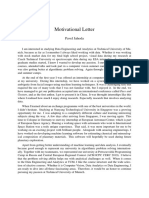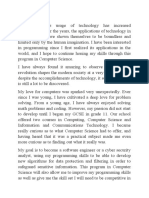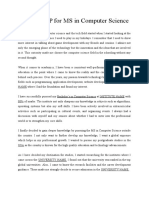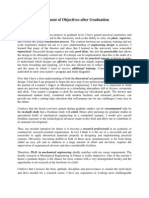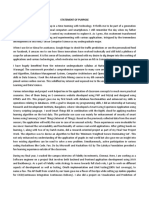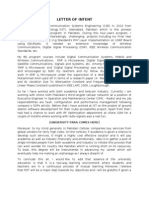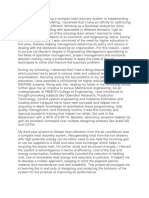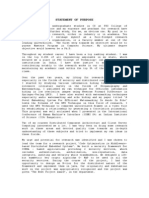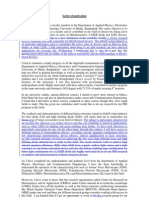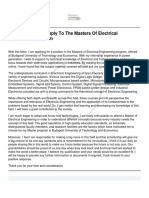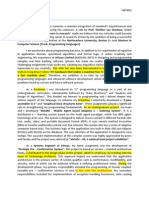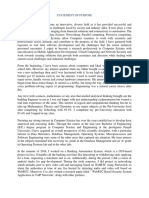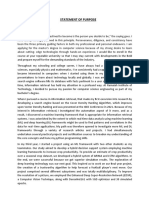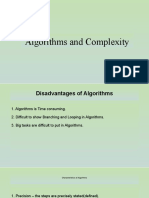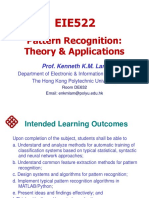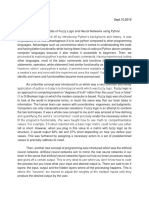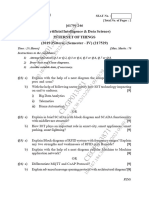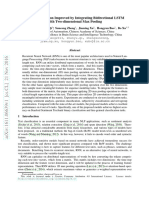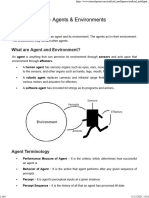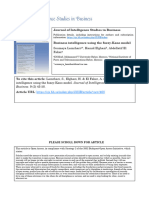Uottawa Statement of Intent
Uploaded by
nihal bhandaryUottawa Statement of Intent
Uploaded by
nihal bhandaryStatement of Intent
The ever-evolving nature of Computer Science is something that charmed my interest in the field, from the
very beginning. Its dynamic nature and its widespread application in different facets of our society are
deeply fascinating. Nurturing that curiosity in mind, I understood there was no other way to pursue, but to
do my bachelor’s degree in Computer Engineering - to absorb and understand everything I could regarding
this field. As I am nearing the end of my first academic journey, I am left with even more eagerness than
before to learn, along with numerous questions yet to be answered. Joining the University of Ottawa’s
Master’s Program would be an exquisite chance to immerse myself in machine learning and computer
vision.
I was introduced to core subjects like algorithms, data structures, compilers, and OS as I began my
bachelor’s in Computer Engineering. I was fascinated by the P vs NP problems, the implication it possesses
if P = NP is proven is astounding. These courses greatly helped in building an overall skill set for building
applications and putting concepts learned into practice. I had participated in several hackathons throughout
my four years of bachelor’s to test and perfect my skills and to obtain a good learning experience. These
experiences have shaped my will and desire to pursue a master’s degree in computer science. As my interest
increased in developing real-life applications, I felt the need to broaden my knowledge in the area of data
science and AI. For this purpose, a master’s degree in computer science with AI specialization will give me
the appropriate knowledge and exposure.
During my undergrad, I did two major projects which involved the extensive application of machine
learning and computer vision concepts. My peers and I managed to build a machine learning model that
can differentiate between a healthy eye and a cataract eye, as our third-year project. The system was based
on a CNN model, which trained on a dataset of both healthy and cataract eyes to differentiate and classify
one and another. During this project, I was bewitched by the field of computer vision and machine learning.
I was able to learn and better understand how to collect datasets, and to filter them according to the provided
need. Working with raw data shed some light on how it forms a major part of the overall process of the
machine learning pipeline.
Furthering my interest in computer vision, I took up a challenging topic for my final year project: an AI-
based Navigator for visually impaired people. I intended to build a navigation system for visually impaired
people mainly assisting in the detection of objects in their vicinity and help in looking for specific objects
they seek. It consisted of a camera, a microprocessor, and an earpiece for audio output. For this system to
be actually useful for the end-user, it needed to be quick and provide real-time assistance, and to be
affordable which made a formidable challenge considering the constraints put up on the project. The
memory, processing power, and camera constraints propelled me into looking for different techniques,
methods, and algorithms that would give the best results. After evaluating different neural network
architectures like Single Shot detection (SSD), R-CNN, F-CNN, and YOLO, I chose YOLO for the
implementation of the project. This allowed me to evaluate and understand other algorithms and possible
scenarios where they might be more applicable. I strongly believe that this learning process would be greatly
improved with the supervision of faculty from your university who are actively pursuing original research
in this direction of computer vision and machine learning.
I worked as an intern for Nuclei Technologies, where I built an android application for the Rendt project.
My responsibilities included coding sections of the application, working on the backend of the application,
and testing/debugging the code before release. As part of the work, I got acquainted with machine learning
tools kits where software developers can use them for application without any domain knowledge. I intend
to use the knowledge and expertise gained from your program in areas where computer vision and machine
learning are imperative. Autonomous vehicles, facial recognition systems, and healthcare are some of the
domains I wish to work in the future. I firmly believe that the Master’s Program will be an outstanding
opportunity to immerse myself in this field, as well as building strong foundations to thrive in my
professional career.
The EECS department of uOttawa is especially attractive to me. I am intrigued by several interesting
research projects carried on by its faculty members. In particular, Professor Lionel Briand research in offline
and online models using DNNs is fascinating; his work on “Comparing Offline and Online Testing of Deep
Neural Networks: An Autonomous Car Case Study” were especially interesting to read. My research
interest has also led me to follow other works of Briand's. I especially enjoyed reading the paper about “A
Machine Learning-Driven Evolutionary Approach for Testing Web Application Firewalls.” It would be a
privilege to study in the EECS department of uOttawa under the guidance of its remarkable faculty.
You might also like
- Personal Statement (1000 Words) : ##Please Refer To This Link For Georgia Tech Specific SopNo ratings yetPersonal Statement (1000 Words) : ##Please Refer To This Link For Georgia Tech Specific Sop3 pages
- Sample SOP For MS in Computer Science 3499812f54No ratings yetSample SOP For MS in Computer Science 3499812f542 pages
- How Should A Statement of Purpose For Masters in Data Science BeNo ratings yetHow Should A Statement of Purpose For Masters in Data Science Be1 page
- SOP - Harsh Tripathi - UEL - BSC (Hons) Computer Science - Fall 22No ratings yetSOP - Harsh Tripathi - UEL - BSC (Hons) Computer Science - Fall 224 pages
- Statement of Purpose - : (Shashank Gaur)No ratings yetStatement of Purpose - : (Shashank Gaur)3 pages
- Electrical and Electronics Engineering StudentNo ratings yetElectrical and Electronics Engineering Student2 pages
- My Motivation To Apply To The Masters of Electrical Engineering Program PDFNo ratings yetMy Motivation To Apply To The Masters of Electrical Engineering Program PDF2 pages
- Intrinsic and Extrinsic Evaluations of Word Embeddings: Michael Zhai, Johnny Tan, Jinho D. ChoiNo ratings yetIntrinsic and Extrinsic Evaluations of Word Embeddings: Michael Zhai, Johnny Tan, Jinho D. Choi2 pages
- PSO and Its Variants: Swarm Intelligence Group Peking UniversityNo ratings yetPSO and Its Variants: Swarm Intelligence Group Peking University70 pages
- Data Mining Using Decision Trees: Professor J. F. BaldwinNo ratings yetData Mining Using Decision Trees: Professor J. F. Baldwin26 pages
- Fundamentals of Process Control Theory ThirdEd - Murrill - Unit2100% (1)Fundamentals of Process Control Theory ThirdEd - Murrill - Unit210 pages
- Text Classification Improved BT Integrating Bidirectional LSTM With Two-Dimensional Max PoolingNo ratings yetText Classification Improved BT Integrating Bidirectional LSTM With Two-Dimensional Max Pooling11 pages
- The Unique of Body Language in Different PlaccesNo ratings yetThe Unique of Body Language in Different Placces6 pages
- Convolutional Neural Network For A Self-Driving Car in A Virtual EnvironmentNo ratings yetConvolutional Neural Network For A Self-Driving Car in A Virtual Environment6 pages
- Business Intelligence Using The Fuzzy-Kano ModelNo ratings yetBusiness Intelligence Using The Fuzzy-Kano Model17 pages
- BBT 3201 - Introduction To AI Concepts - August 2019No ratings yetBBT 3201 - Introduction To AI Concepts - August 20197 pages
- Glossary of Common Machine Learning, Statistics and Data Science Terms - Analytics VidhyaNo ratings yetGlossary of Common Machine Learning, Statistics and Data Science Terms - Analytics Vidhya54 pages
- Artificial Neural Network and Its ApplicationsNo ratings yetArtificial Neural Network and Its Applications21 pages
- Introduction To Complexity Theory Lecture 4: Space ComplexityNo ratings yetIntroduction To Complexity Theory Lecture 4: Space Complexity8 pages
- Microproject On ETL Process For Data AnalyticsNo ratings yetMicroproject On ETL Process For Data Analytics6 pages
- A Sentiment Analysis Case Study To Understand How A Youtuber Can Derive Decision Insights From CommentsNo ratings yetA Sentiment Analysis Case Study To Understand How A Youtuber Can Derive Decision Insights From Comments9 pages
- Paper 7 - The Object Detection Based On Deep LearningNo ratings yetPaper 7 - The Object Detection Based On Deep Learning6 pages



